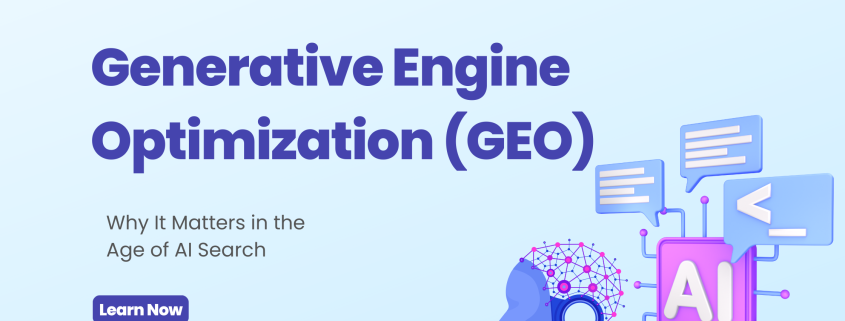Generative Engine Optimization (GEO): Why It Matters in the Age of AI Search
For many years, companies focused on SEO—Search Engine Optimization — to get found online. The idea was simple: people typed questions into Google, and Google showed a list of website links. If a company ranked high, they got more traffic. But the way people search is changing. Today, more and more buyers are using AI search tools like ChatGPT, Perplexity, and Gemini. Instead of showing a regular list of links, these tools return answers—written in natural language. Google is already moving in this direction with AI Overviews. This shift means something major:
The goal is no longer just ranking high. The goal is being selected as a source. That new approach is called Generative Engine Optimization (GEO). GEO means writing content that AI models can read easily, understand clearly, and reuse when they answer questions. Instead of only trying to get your website to the top of a search results page, GEO helps your ideas show up inside the answer itself. In other words, SEO helps humans find you. GEO helps AI choose you.
Why GEO matters for B2B SaaS and mid-market companies
There is a major shift happening in the buyer journey—especially in B2B. Buyers are researching earlier, faster, and through more AI-powered surfaces. Many SaaS companies notice this already. Demo requests come through — but analytics show fewer website pages visited first. That means buyers are learning somewhere else before they click. And that “somewhere else” is often a generative summary.
This is why Generative Engine Optimization is not optional. GEO protects your discoverability in a world where AI search answers are becoming the first (and sometimes only) step in research.
GEO vs SEO—what’s really different?
SEO focuses on visibility. GEO focuses on selectability. This is a simple idea but a major shift. With SEO → the goal is to appear in the list. With GEO → the goal is to appear in the answer. This means content must be written differently. In the GEO world, the best content is:
- clear
- direct
- well structured
- easy for models to quote
For example, HubSpot, Notion, and Monday.com often get cited in AI results—not because they “write more”—but because their content is structured in a way that AI can easily parse and reuse.
The 3 places GEO matters most
GEO affects three parts of the new search landscape:
1) AI search engines
ChatGPT, Perplexity, Claude, and Gemini pull from many data sources to create a final answer. They may reference your content directly or use your ideas indirectly.
2) Google AI Overviews
Google uses AI to summarize answers at the top of the page. This means many people may not scroll down to the links anymore—so the real win is being used in the summary.
3) AI model inference
Models learn from patterns in text. Even if they don’t link to you directly, they might use your language as part of their “knowledge base.”
This means GEO isn’t ONLY about search engines anymore. It’s about becoming part of the information the model repeats.
GEO changes how we write content
Traditional SEO rewarded cleverness and keyword tricks at times. GEO rewards clarity. AI models don’t like vague language or fluffy marketing language. They need:
- clear definitions
- short sentences
- well-labeled sections
- direct answers to questions
GEO content should feel almost like a helpful guide or handbook—not a pitch. It should look like something someone could learn from—even if they only read one section.
How GEO helps the revenue engine
In mid-market SaaS, the buying process is long and full of research steps. GEO helps companies win earlier in the journey—long before the website click. That means sales cycles can shorten—because belief and trust can form faster. It also means inbound content will need new ways to measure success. Instead of only asking: “How many organic sessions did we get?” Companies will soon ask: “How often does our language show up in generative answers?” That is the new visibility metric.
GEO and content quality
GEO forces marketers to do something most companies have avoided: say things clearly. Many brands write in a vague, “brand-safe,” soft style. They explain around concepts. They suggest value instead of stating it. They describe benefits but don’t define terms.
AI does not reward this.
The more exact your language is,AI the more likely AI will reuse it. Clear language becomes a competitive advantage.
Where GEO is heading next
Over the next few years, GEO will likely become the default structure used in content planning. It will not kill SEO — it will live next to it. Think of GEO as the next layer of search.
- SEO makes you visible to humans
- GEO makes you usable by machines
Both matter. But GEO is the newer advantage. Teams that adopt it earlier will build stronger authority in AI search — because they will become the “example language” that models select when answering questions.
Final thought
Marketing teams don’t need more content. They need stronger content. Generative Engine Optimization helps companies create content that is not only helpful to human readers — but also clear enough for AI to reuse. That is how companies protect their organic presence in the next era of search. GEO is where authority compounds next — not through volume — but through clarity.



